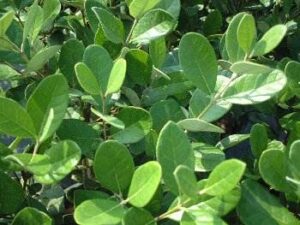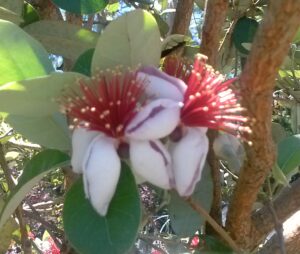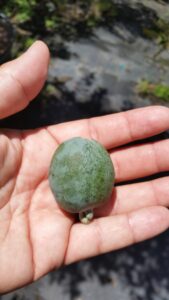S & J Nursery’s Guide to Growing
Pineapple Guava / Feijoa
For Northeast Florida Jacksonville | St. Augustine area Landscapes
(Acca Sellowiana)
Pineapple Guava Origins:
– Acca Sellowiana is a South American native plant that has been selected as one of the Florida Friendly plants
of the year in 2009 by the FNGLA ( Florida Nursery Landscape and Growers Association)
Pineapple Guava Exposure:
– Plant Pineapple Guava in a full sun or partially shaded location in the North Florida | Jacksonville | St. Augustine area landscapes.
Pineapple Guava / Feijoa Foliage:
– Pineapple Guava’s new growth is a bright green with silvery green undersides that matures to a deep almost olive green color.
– Evergreen
 Pineapple Guava Soil Preference / Salt tolerance:
Pineapple Guava Soil Preference / Salt tolerance:
– Pineapple Guava ( Acca Sellowiana ) is tolerant of a wide range of soil conditions providing they are planted in a well draining location. –
– Low maintenance landscape plant option
– High salt tolerance makes Pineapple Guava an excellent landscape choice for the coastal areas of North Florida landscapes.
Pineapple Guava Size Variance:
– Pineapple Guava can grow up to 8-15 ft high and wide if left to grow unpruned, although most often kept as low as 3-4 ft High and 2-3 ft wide with just an annual pruning.
Pineapple Guava Growth Habit:
– Pineapple Guava / Feijoa Sellowiana has an upright rounded growth habit but responds well to pruning and can be easily kept as a formal squared off box hedge or allowed to grow into a single or multiple trunked accent tree with a rounded head with minimal pruning.
– Here at S & J Nursery we sell them both as a shrub in a shrub form and grown with the foliage cleared as trees for accent planting along the foundation of homes or commercial sites.
Pineapple Guava Growth Rate:
– Pineapple Guava is a medium to fast growing shrub for the North Florida landscape.
– Here at S & J Nursery where they are well watered and fertilized every 3-4 months we expect to get 6-8 inches or more of growth on them each year.
Pineapple Guava Bloom:
– Feijoa’s stunning silvery foliage is accented beautifully in late spring to early summer when the plant begins to bloom. Pineapple guava blooms are 1- 2 inch blooms have red stamens and white petals, they remind me of almost a miniature passionflower.
– Blooms are edible and can be used in salads or as a garnish.
– Pineapple guavas blooms are followed by 1-3 inch long oval fruit that starts out a grayish green color and matures to a soft yellow when ripe. The fruits are very sweet and have a hint of pineapple flavor to them, they
are a favorite with children and adults alike for eating fresh from the tree and can be used in jams and jellies.
Pineapple Guava / Feijoa Water Requirements:
– Drought tolerant landscape selection once established into the landscape.
Best Uses For Pineapple Guava / Feijoa in the  North Florida | Jacksonville | St. Augustine area landscape :
North Florida | Jacksonville | St. Augustine area landscape :
– Low maintenance landscape plant option
– Pineapple Guava / Feijoa makes an excellent evergreen privacy screen or taller hedge row for the back of the border or foundation planting. Plant where space from surrounding hardscapes or buildings make its narrow growth habit advantageous.
– Beautiful accent when grown into a patio tree form.
– Allow this tree to grow removing the lower branches to clear it up as a tree and Pineapple Guava / Feijoa will make an excellent Xeroscapes accent planting or ornamental tree.
– Pineapple Guava / Feijoa responds well to pruning.
– Low maintenance landscape plant selection!
Care of S & J Nursery’s North Florida | Jacksonville | St. Augustine Shrubs:
– Shrubs can be planted in the North Florida | Jacksonville | St.Augustine area at any time during the year. In normal and well draining soils dig the hole as deep as the root ball and two to three times as wide. Plant the top
of the root ball level or slightly higher than the surrounding soils. When planting in poorly drained soils make sure to plant your shrubs a minimum of 3 inches ABOVE the surrounding soil level.
– Water every day during the establishment period. For most 3 gallon size shrubs in the North Florida landscape in average soil, that is neither heavy clay that holds water or really sandy that will take 2-3 weeks of daily
watering to ensure that your newly planted shrub will begin to put out new roots and grow into its new home happily. After the first few weeks begin tapering back your watering to every other day then every third day and so
on until your newly planted items are flourishing without your assistance.
– If planting larger shrubs you may need to extend the initial care a bit longer to protect your investment and get your shrubs off to the best start possible.
– IMPORTANT: If planting shrubs in heavy clay soils that hold allot of water after a rain or irrigating, remember to check the soil for moisture by sticking your fingers into the soil near the root ball of the newly
planted shrub down to 2-3 inches. If it remains wet from the previous watering wait for the top 2-3 inches to dry out before watering again.
– IMPORTANT: When planting shrubs into poor sandy soils be sure to amend the planting hole by mixing compost or cow manure etc. with the native soil that will go back in the hole around the new plants root ball when installing your shrub material, this will not only give your new shrubs good soil to grow its new roots into but help it hold water.
– When planting shrubs from containers be sure to loosen the roots as much as possible pulling loose roots away from the root ball before installing your new plants, if the roots are to tight to easily loosen with your hands
use a knife to cut a few slits into the root ball being careful to go all the way from the top to the bottom and making the cut at least an inch deep. This will ensure that your plant will immediately begin to form new roots
into its new surrounding soil.
– Mulch newly planted shrubs whenever possible.
– Fertilize each spring with a mixture of milorganite and a slow release poly coated plant food such as Osmocote or Stay Green general purpose plant food, sprinkling the fertilizer around the mulch circle underneath the foliage of the tree.
– Prune as needed to shape each spring and or summer.

